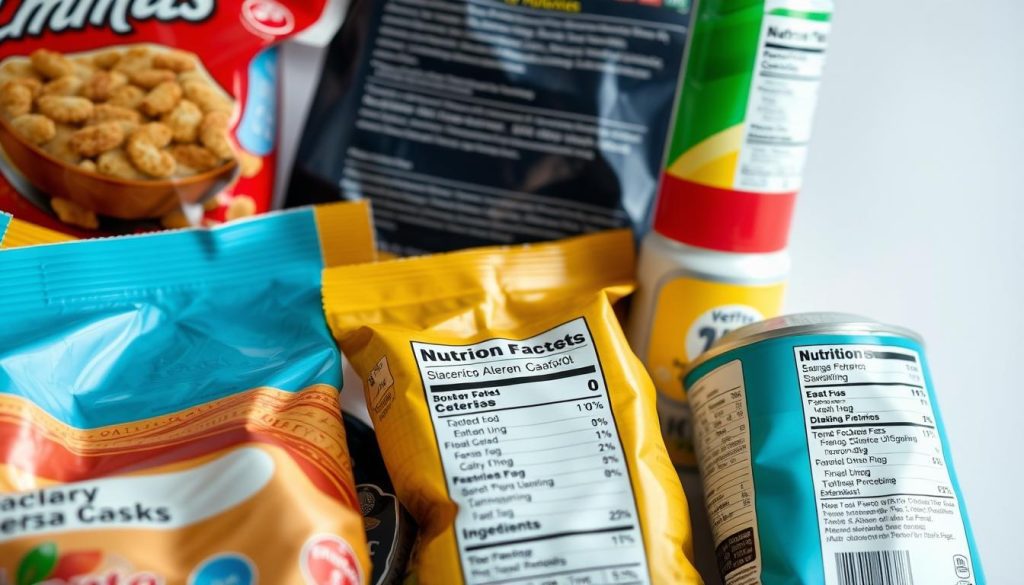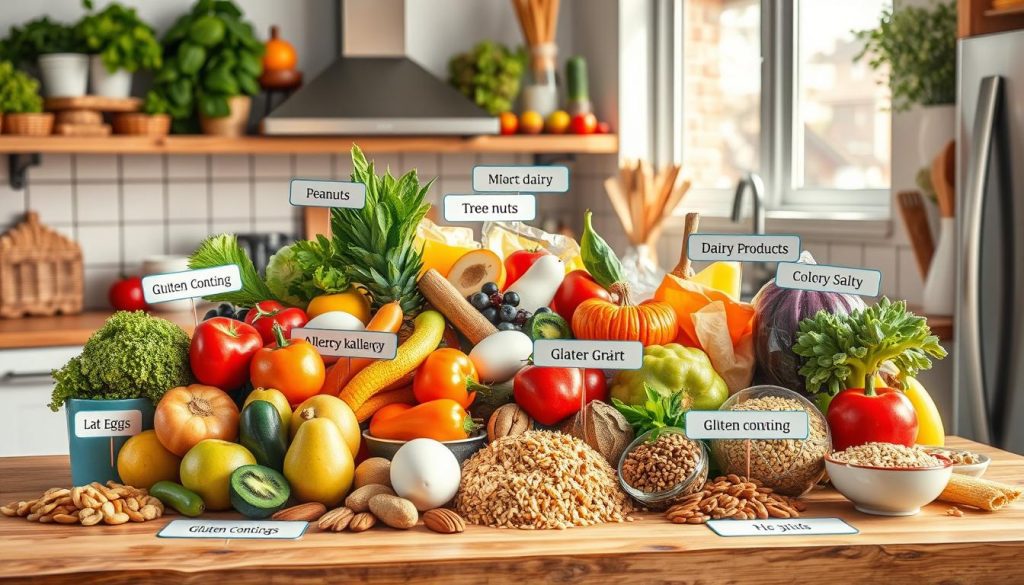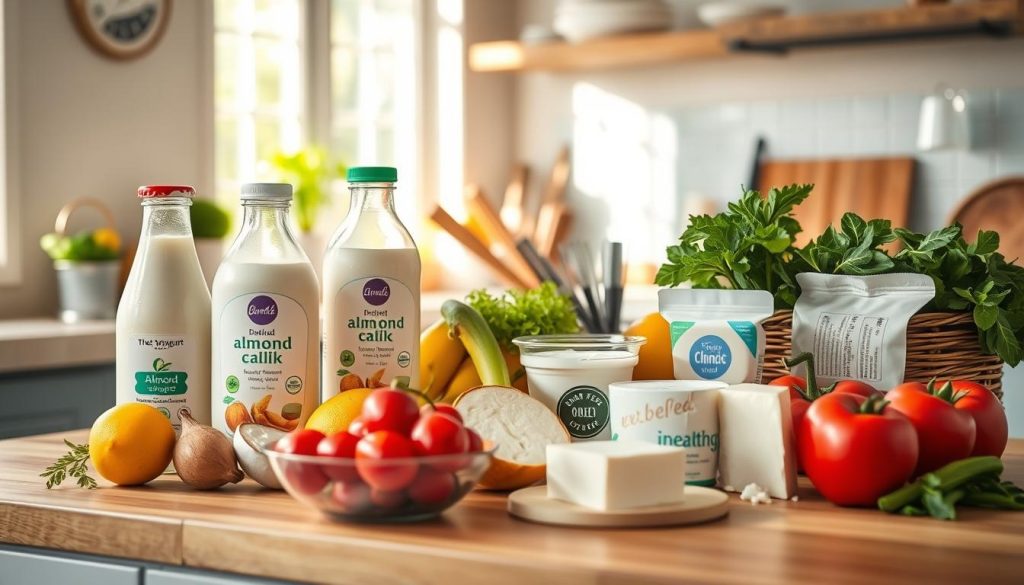How to Identify and Avoid Common Food Allergens
How to Identify and Avoid Common Food Allergens
Food allergies are more common in the United States, affecting millions. It’s important to know the most common food allergens and how to avoid them. This guide will help you understand food allergies, their symptoms, and how to protect yourself or your loved ones.

Key Takeaways
- Food allergies are on the rise in the US, affecting millions of people
- Identifying common food allergens is essential for managing allergic reactions
- Understanding the difference between food allergies and food intolerances is crucial
- Recognizing the symptoms of food allergies, both immediate and delayed, is important
- Properly reading food labels and being cautious of hidden allergens is necessary for avoidance
Understanding Food Allergies vs. Food Intolerances
Food allergies and food intolerances are different, even though they seem similar. Knowing the differences helps people manage their symptoms better. It also keeps them healthy and happy.
Key Differences in Symptoms and Reactions
Food allergies happen when the immune system reacts too much to certain foods. This can cause mild symptoms like hives or more serious ones like anaphylaxis. Food intolerances, however, are about the body having trouble digesting certain foods. This leads to digestive discomfort, but it’s not an immune system issue.
Impact on Daily Life and Health
- Food allergies can really affect daily life. People with allergies must always be careful to avoid certain foods to prevent allergic reactions.
- Food intolerances might not be as severe, but they can still mess up daily life. They cause ongoing digestive symptoms.
- Not treating or managing food allergies and intolerances can lead to serious health problems. This shows why getting medical help is so important.
| Characteristic | Food Allergy | Food Intolerance |
|---|---|---|
| Immune System Involvement | Involves an immune system response | Does not involve the immune system |
| Severity of Reactions | Can range from mild to life-threatening anaphylaxis | Typically causes digestive discomfort but not life-threatening |
| Onset of Symptoms | Symptoms usually appear quickly, within minutes or hours | Symptoms may take hours or days to develop |
| Dietary Restrictions | Strict avoidance of the offending food is required | May be able to tolerate small amounts of the problem food |
Understanding the differences between food allergies and intolerances helps people manage their health. It ensures they can live a good life.
The Most Common Food Allergens in the United States
Some foods are more likely to cause allergies in the US. Knowing which ones can help people with allergies stay safe. Let’s look at the eight most common food allergens in the US and how they can affect people.
Milk and dairy products are big culprits, affecting 2.5% of kids and 1.2% of adults. Dairy allergies can cause stomach problems and skin issues.
Eggs are also common, affecting 1.9% of kids and 0.2% of adults. Egg allergies can lead to hives, swelling, and even anaphylaxis in serious cases.
- Peanuts are a leading cause of food allergy, affecting 2.2% of the US population. Peanut allergies can be dangerous, potentially leading to life-threatening reactions.
- Tree nuts, such as almonds, walnuts, and cashews, affect around 0.6% of Americans. These allergies can be tricky, as different tree nuts can cause similar reactions.
Fish and shellfish allergies affect about 0.6% and 2.0% of the US population, respectively. These allergies can cause severe symptoms, including breathing problems and heart issues.
| Allergen | Prevalence in the US |
|---|---|
| Milk | 2.5% of children, 1.2% of adults |
| Eggs | 1.9% of children, 0.2% of adults |
| Peanuts | 2.2% of the population |
| Tree Nuts | 0.6% of the population |
| Fish | 0.6% of the population |
| Shellfish | 2.0% of the population |
| Soy | 0.4% of children, 0.3% of adults |
| Wheat | 0.4% of children, 0.2% of adults |
Soy and wheat allergies are also common, affecting 0.4% of kids and 0.3% of adults for soy, and 0.4% of kids and 0.2% of adults for wheat.
Knowing about these common allergens is key to staying safe and healthy. By being aware of these foods, we can avoid harmful reactions. This way, everyone can enjoy their meals without worry.

Recognizing Food Allergy Symptoms and Warning Signs
Understanding food allergies is key. It’s important to know the symptoms and warning signs. From mild to severe, knowing how to react is crucial.
Immediate Allergic Reactions
Food allergens can cause reactions quickly. Symptoms include hives, rashes, and itching. Swelling and trouble breathing are also signs.
Nausea and vomiting are common too. These reactions need quick medical help.
Delayed Allergic Responses
Some allergies show up hours or days later. Symptoms like stomach pain and diarrhea are signs. Fatigue, headaches, and joint pain can also indicate an allergy.
When to Seek Emergency Care
- If someone has trouble breathing or swelling, call 911. Seek emergency care right away.
- Severe reactions need epinephrine fast. This medicine can save lives.
- See a doctor for ongoing or worsening symptoms. They can find the cause and help.
Knowing all about allergic reactions is vital. It helps manage food allergies and keeps people safe.
Essential Guide to Reading Food Labels
Understanding food labels can be tough, especially for those with food allergies. It’s crucial to know how to read labels to avoid allergens. This guide will help you make smart choices when shopping.
Deciphering FDA Labeling Requirements
The FDA requires food labels to list eight common allergens. These are milk, eggs, peanuts, tree nuts, wheat, soy, fish, and crustacean shellfish. Labels must clearly state these allergens in simple terms.
Identifying Allergens on the Ingredient List
When checking the ingredient list, look for terms like “casein” or “whey” for milk. “Soy protein” or “soy lecithin” means soy is present. Knowing these terms helps you choose safer foods.
Navigating Precautionary Statements
Labels also have voluntary statements like “may contain” or “processed in a facility that also processes.” These warnings are about cross-contamination. It’s wise to avoid products with these warnings.
| Allergen | Common Ingredient Names |
|---|---|
| Milk | Casein, whey, lactose, butter, cheese, cream, custard, ghee, ice cream, milk solids, yogurt |
| Eggs | Albumin, egg, egg white, egg yolk, meringue, mayonnaise |
| Peanuts | Peanut, peanut butter, peanut oil, ground nuts |
| Tree Nuts | Almonds, Brazil nuts, cashews, hazelnuts, macadamia nuts, pecans, pine nuts, pistachios, walnuts |
Being careful with food labels is vital for avoiding food allergens. With practice, you can confidently shop for your dietary needs.

Hidden Sources of Common Allergens in Processed Foods
Processed foods can be tricky for people with food allergies. There are hidden allergens in many foods. It’s important to watch out for these to stay safe.
Unexpected Ingredients to Watch For
Many foods have additives and flavorings that might surprise you. Some of these come from common allergens like dairy, soy, or nuts. Always check the label to find these hidden allergens.
Cross-Contamination Risks
Food manufacturing can also be risky for allergy sufferers. Equipment and shared spaces can mix allergens into foods. This is especially dangerous for those with severe allergies.
| Potential Hidden Allergen | Common Sources |
|---|---|
| Dairy | Whey, casein, lactose, butter, cheese, cream |
| Soy | Soybean oil, soy lecithin, soy protein, soy sauce |
| Nuts | Nut oils, nut extracts, nut flavorings |
| Wheat | Flour, bran, starch, modified food starch |
Knowing about hidden allergens and cross-contamination can help. Being careful with food labels and talking to manufacturers is key. This way, people with allergies can feel safer when eating processed foods.
Living with Food Allergy: Practical Tips for Daily Management
Managing a food allergy can seem tough, but with the right strategies, you can handle daily life with confidence. From planning meals to eating out, these tips will help you control your food allergy. You can live a healthy and fulfilling life.
Meal Planning and Grocery Shopping
Plan your meals ahead to have safe, allergen-free options. When shopping, read food labels to avoid ingredients that can cause allergic reactions. Keep a list of safe and unsafe foods to help while shopping.
- Invest in a quality food processor or blender for allergy-friendly meals at home.
- Try new recipes and substitute ingredients to make tasty, allergen-free dishes.
- Keep versatile staples like gluten-free grains, nut-free butters, and dairy-free milk on hand.
Communicating with Others
Talking openly about your food allergy with friends, family, and workmates is key. It ensures your safety and prevents accidental exposure. Don’t hesitate to speak up for your needs in social and work settings.
- Carry allergy-awareness cards or brochures to share with restaurants and hosts.
- Teach your loved ones about allergic reaction signs and symptoms, and how to respond in emergencies.
- Consider an elimination diet to find and manage your food allergens.
| Tip | Description |
|---|---|
| Meal Planning | Plan your meals in advance to ensure you have safe, allergen-free options on hand. |
| Ingredient Substitution | Experiment with new recipes and substitute ingredients to create delicious, allergen-free dishes. |
| Allergy Awareness | Openly discuss your food allergy with friends, family, and colleagues to ensure your safety and prevent accidental exposure. |
By using these practical tips, you can manage your food allergy well. You can live a healthy, active life. Remember, with the right strategies and support, a food allergy doesn’t have to limit your enjoyment of life.

Safe Food Preparation and Cross-Contamination Prevention
Keeping a kitchen safe and free from allergens is key for those with food allergies. It’s vital to stick to strict kitchen safety rules to avoid cross-contamination. This ensures the safety of those with dietary restrictions.
Kitchen Safety Protocols
Begin by cleaning all surfaces, utensils, and cookware well before starting to cook. Use separate cutting boards and knives for each allergen to prevent cross-contamination. Always sanitize the work area and wash your hands with soap and water before and during cooking.
- Dedicate separate storage containers for different food allergens
- Avoid using the same oil or cooking equipment for multiple dishes
- Carefully read ingredient labels to identify potential allergens
- Establish a designated “allergy-free” zone in the kitchen
Dining Out Precautions
Talking to the restaurant staff is key when dining out. Tell your server about your food allergy and any special dietary needs. Ask that your meal be made in a dedicated, allergen-free area of the kitchen. It’s also wise to pick places known for being friendly to customers with food allergies.
| Dining Out Tips | Recommended Actions |
|---|---|
| Review the menu in advance | Identify dishes that are safe for your dietary needs |
| Speak with the server or chef | Clearly communicate your food allergy and ensure proper preparation |
| Consider alternative dining options | Choose restaurants with dedicated allergy-friendly menus or policies |
By sticking to these guidelines for safe food preparation and dining out, people with food allergies can enjoy tasty meals. This way, they can also lower the risk of cross-contamination.
Emergency Response Plan for Allergic Reactions
Living with food allergies means being proactive. A good emergency plan is key. In case of an anaphylactic reaction, quick action is vital. At the center of this plan is using an epinephrine auto-injector correctly. This device is a lifesaver and should always be with you.
To be ready for emergencies, follow these steps:
- Know your allergens: Start by figuring out which foods cause your reactions. This helps you prepare better.
- Always carry epinephrine: Make sure you have an epinephrine auto-injector with you. Also, tell family and friends where it is and how to use it.
- Watch for signs of anaphylaxis: Keep an eye out for symptoms like hives, swelling, trouble breathing, and feeling dizzy. These could mean you’re having a severe allergic reaction.
- Act fast: If you have a reaction, use the epinephrine auto-injector right away and call for help. Quick action is crucial in treating anaphylaxis.
- Get medical help: Even after using epinephrine, you need to see a doctor. The reaction might get worse or last longer.
By being proactive and having a solid emergency plan, you can handle food allergies better. This can greatly improve your chances of dealing with a serious situation.

“Prompt treatment with epinephrine is the first line of defense against a severe allergic reaction.”
Being informed and ready can protect your health. Spend time making and updating your emergency plan. This way, you’ll be ready to act fast and effectively in an allergic emergency.
Understanding Food Allergy Testing and Diagnosis
Finding out what causes a food allergy is key to managing it well. Doctors use different methods to find out what foods cause allergies. These include skin prick tests and blood tests, which help understand how the body reacts to certain foods.
Different Types of Allergy Tests
The skin prick test is a common way to check for food allergies. It involves putting a tiny bit of the suspected allergen on the skin. Then, doctors watch for signs like redness, swelling, or itching.
Blood tests, on the other hand, check for IgE antibodies in the blood. These antibodies are made when the body reacts to certain foods.
At times, doctors might suggest an oral food challenge. This means eating a small amount of the suspected allergen under close watch. It helps figure out if a food allergy is real and how severe it is.
Working with Allergists
Seeing an allergist is very important for diagnosing and managing food allergies. These doctors are experts in interpreting test results and creating treatment plans. They also teach patients how to avoid and manage food allergens.
| Test | Description | Pros | Cons |
|---|---|---|---|
| Skin Prick Test | Involves applying small amounts of suspected allergens to the skin and observing any reactions. | – Provides quick results – Widely available | – May cause discomfort – Can produce false positives |
| Blood Test | Measures the levels of specific IgE antibodies in the blood. | – Doesn’t require exposure to allergen – Can test for multiple allergens at once | – May take longer to get results – Can also produce false positives |
| Oral Food Challenge | Involves consuming a small amount of the suspected allergen under medical supervision. | – Considered the “gold standard” for diagnosis – Provides definitive results | – Carries a risk of severe reaction – Requires specialized medical setting |
By teaming up with an allergist, people can learn a lot about their food allergies. This helps them manage their allergies better, leading to a safer and healthier life.
Alternative Food Options and Substitutions
For those with dairy allergies or food intolerances, finding good substitutes is hard. But today, we have many choices to keep our diets balanced and healthy. We can avoid foods that make us sick.
Dairy is a big problem for many. Luckily, we have many dairy-free milks like almond, soy, oat, and coconut. These plant-based milks are great for those with dairy allergies. They also offer health benefits.
- Almond milk is full of vitamins E and D, plus calcium.
- Soy milk has lots of protein and isoflavones, which might help fight inflammation.
- Oat milk is packed with fiber and beta-glucan, which can lower cholesterol.
- Coconut milk is creamy and tasty, and it has medium-chain triglycerides (MCTs).
But dairy isn’t the only issue. Food intolerances can also make it hard to eat gluten, nuts, soy, and more. Luckily, there are many gluten-free, nut-free, and soy-free options out there. For example:
- Gluten-free flours like rice, almond, and coconut.
- Nut-free butters like sunflower seed and tahini.
- Soy-free condiments and seasonings.
By trying these alternatives, people with dairy allergies or food intolerances can still enjoy a wide variety of foods. They can do this without hurting their health or happiness.

“The key to managing food allergies or intolerances is to be informed, proactive, and open to exploring new and delicious alternatives.”
Conclusion
As we wrap up this guide on food allergens, remember to stay informed and proactive. Knowing the difference between allergies and intolerances is key. Also, understanding common allergens and how to read food labels helps you manage your health.
Being aware and educated is vital for managing food allergies. Talk to your doctor to figure out your allergies and make a safety plan. Learn the signs of an allergic reaction and know how to act fast to keep yourself safe.
Being careful and speaking up is important when you have a food allergy. With the right steps, you can enjoy meals and live a healthy life. By sharing our knowledge, we can make the world more welcoming for everyone with allergies.
FAQ
What are the most common food allergens in the United States?
In the U.S., the top food allergens are milk, eggs, peanuts, tree nuts, fish, shellfish, soy, and wheat. These are the main culprits behind most food allergies. They must be clearly labeled on food products.
How can I tell the difference between a food allergy and a food intolerance?
Food allergies involve the immune system and can be life-threatening. They cause severe reactions. On the other hand, food intolerances are digestive issues that aren’t life-threatening. They might cause bloating, gas, or diarrhea over time.
What are the symptoms of a food allergy, and when should I seek emergency care?
Symptoms of food allergies range from mild (hives, itching, swelling) to severe (difficulty breathing, dizziness, loss of consciousness). Anaphylaxis is a serious reaction that needs immediate medical help. This includes using an epinephrine auto-injector and going to the emergency room.
How can I read food labels to identify potential allergens?
The FDA requires the top eight allergens to be listed on food labels. Look for “milk,” “eggs,” “peanuts,” “tree nuts,” “fish,” “shellfish,” “soy,” and “wheat.” Also, be aware of less obvious names for these allergens.
What are some hidden sources of common allergens in processed foods?
Allergens can hide in flavorings, seasonings, and additives. Cross-contamination is also a risk. Always check for “may contain” or “processed in a facility that also processes” statements on labels.
How can I safely prepare food at home to avoid cross-contamination?
Use separate cutting boards, utensils, and areas for allergen-containing foods. Clean all surfaces and equipment well before making allergy-friendly meals. When eating out, tell the staff about your allergies and ask about their safety steps.
What should I do if I experience an allergic reaction?
If you or someone you’re with has anaphylaxis symptoms, act fast. Use epinephrine (if you have it) and call emergency services. Always have a plan and seek medical help for severe reactions.
How can I get tested and diagnosed for food allergies?
See a board-certified allergist for testing. They can do skin prick tests, blood tests, or oral food challenges. They’ll help you avoid triggers and manage reactions.
What are some good alternative food options and substitutions for common allergens?
For dairy allergies, try plant-based milks, cheeses, and yogurts. Use gluten-free grains like quinoa, rice, and flours instead of wheat. There are also nut-free and soy-free products available.